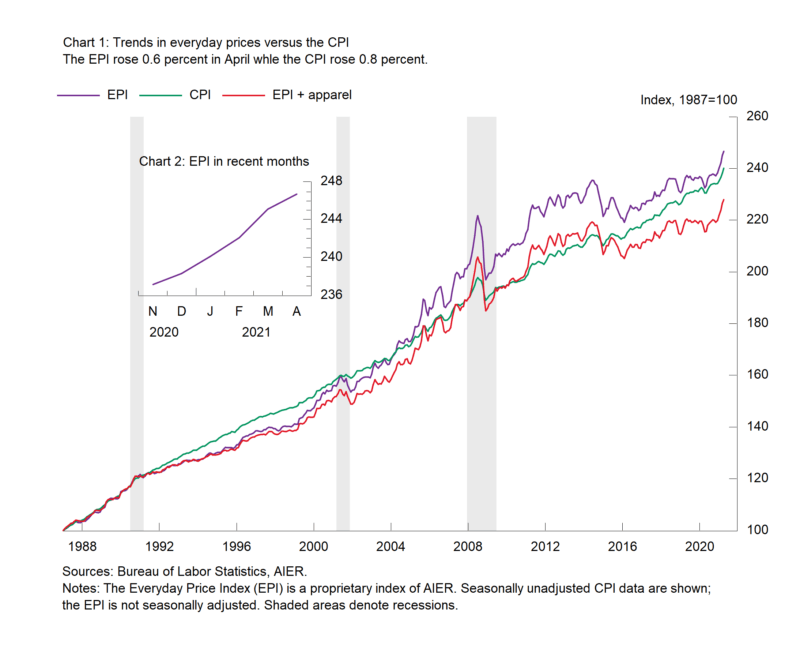The AIER Everyday Price Index increased by 0.6 percent in April, the fifth consecutive gain following back-to-back decreases in October and November. The most recent rise puts the 12-month gain at 6.1 percent, the fastest pace since September 2011.
The positive contributors to the April rise were led by motor fuels prices, up 2.0 percent and contributing 19 basis points, followed by food at home (groceries), up 0.6 percent and adding 14 basis points, household fuels and utilities (up 0.7 percent for the month and contributing 9 basis points), food away from home (up 0.3 percent for the month and contributing 6 basis points), and admissions prices for movies, theaters, concerts, and sporting events, etc., (up 3.4 percent for the month while contributing 6 basis points).
The Everyday Price Index including apparel, a broader measure that includes clothing and shoes, rose 0.6 percent in March, and also the fifth consecutive increase. Over the past year, the Everyday Price Index including apparel is up 5.7 percent, the fastest since September 2011. Apparel prices fell 0.1 percent on a not-seasonally-adjusted basis in April following three consecutive monthly increases. From a year ago, apparel prices are up 1.9 percent.
The Consumer Price Index, which includes everyday purchases as well as infrequently purchased, big-ticket items and contractually fixed items, rose 0.8 percent on a not-seasonally-adjusted basis in April. Over the past year, the Consumer Price Index is up 4.2 percent. The Consumer Price Index excluding food and energy also rose 0.8 percent for the month (not seasonally adjusted) while the 12-month change came in at 3.0 percent.
After seasonal adjustment, the CPI rose 0.8 percent in April while the core increased 0.9 percent for the month, the largest monthly gains since April 1982. Within the core, core goods prices were up 2.0 percent in April and are up 4.4 percent from a year ago while core services prices rose 0.5 percent for the month and are up 2.5 percent from a year ago. Among the notable increases in the core CPI were used car and truck prices, up 10 percent for the month, the largest monthly increase on record, and accounting for more than a third of the seasonally-adjusted increase in the total CPI, as well as airline fares, recreation, motor vehicle insurance, and household furnishings and operations.
Like many measures of activity within the economy, many prices continue to be distorted by government restrictions on consumers and businesses as well as lingering effects from prior restrictions that are causing shortages, logistical and supply chain problems, and labor problems. As activity returns to normal, supply and demand will adapt and likely lead to slower price increases.
Note: The Everyday Price Index for March is based on incomplete data due to restrictions on data collection by Bureau of Labor Statistics personnel because of the Covid-19 pandemic.









Wonder if tarriffs or supply chain failures have anything to do with it?
Thanks very much Biden voters. Your ‘low information’ outlook is now affecting all of us.
This is what Biden’s administration wants…
No gasoline or natural gas to contribute to “climate change”, smaller houses, less consumption, less freedom, fewer people (forced vaccinations)…
The future looks darker, indeed…
Four years of Trump Derangement Syndrome have stirred up the Communist Democrat murder hornets, in cohort with their Communist Chinese funders and partners….